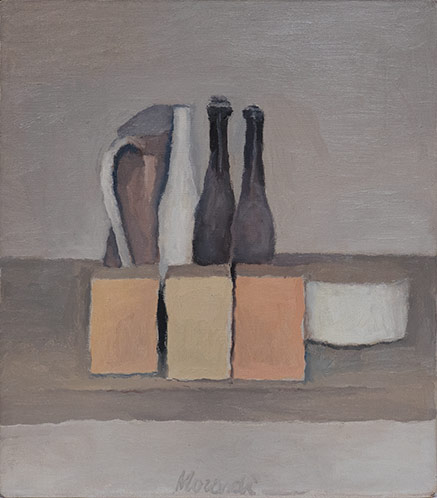
Still Life (Natura morta), 1942
“The feelings and images that the visible world awakens in us are very difficult to express or are perhaps inexpressible with words, because they are determined by forms, colors, space and light”. Morandi, 1957
Giorgio Morandi (1890–1964) spent almost his entire life in the Italian city where he was born, Bologna, which has a longstanding cultural tradition. Even though he achieved great international success, he did not like to travel. Throughout his lifetime, he only visited cities that were relatively close to his hometown, such as Padua, Florence, Venice, Milan, and Rome, along with Winterthur, Switzerland. There, he was able to view the collection of works by prominent Spanish artists such as Murillo, Velázquez, El Greco, and Zurbarán, which belonged to the collection of Count Contini-Bonacossi. Those works had a profound influence on the way he painted, especially in the lighting and the sobriety of his scenes.
Still Life (1942) is an enormously sober, simple work which emanates a profound silence. This image only contains two white porcelain objects: there is an original bottle in the center, which becomes the main focal point since it is the only vertical object in the composition. It shares the scene with a small teacup made of the same material, which is slightly inclined, leaning on the bottle and brightly lit. In fact, this painting particularly stands out for the silvery light that illuminates the scene and is masterfully reflected in the irregular porcelain surface.
In the late 1940s, Morandi’s works began to contain objects that are juxtaposed or situated next to each other, painstakingly laid out on a plane.
The elements that appear in this image are still just everyday household goods, but they are no longer separated from each other as in the initial works in his career. Instead, they form compact units, just as in this other painting entitled Still Life (1956).
This work is part of Morandi’s last period as a painter, which is characterized by the presence of cube shapes that almost become the focal points of his still lifes. In the foreground there are three cube shapes painted in soft yet well-defined colors. In the background, the artist places three bottles and a pitcher, which bring verticality to the scene, along with a low cylindrical box. The two rows of objects, one behind the other, generate a striking sense of spatial depth. By using darker colors to depict several of the vertical elements (bottles), the painting achieves an overall elegant chromatic harmony.
The year Morandi painted this Still Life, he travelled to the Swiss city of Winterthur for the first time, where he saw the paintings by Jean-Baptiste Siméon Chardin, a famous 18th-century painter known as the master of silence and light. Just like Morandi, Chardin painted many still lifes in his career, and he organized the objects in a somewhat disorderly fashion, making them appear natural. Morandi particularly noticed the painting entitled The House of Cards, and he carefully studied the placement of the cards, something which he may have emulated in his 1956 Still Life through the cube shapes he placed in the foreground.
Preguntas
Begin by describing the work: How many objects are there? What size are they? What kind of objects are they? Which ones stand out? What did the artist do to make some of them stand out over the others?
Only two elements appear in this Still Life (1942): a rather eccentrically-shaped bottle and a teacup, both made of white porcelain. Since they are such refined and delicate items, whom do you think they may belong to? What kind of beverage might such a refined, elegant bottle contain?
Morandi believed that the landscape, flowers and still lifes were the real themes suggested by life and thus truly worth reproducing artistically. Therefore, they were practically the only motifs he painted time and time again throughout his career, with a special interest in still lifes. If you had to choose three subjects to inspire your artworks (music, literature, sculpture and painting, etc.) throughout your entire life, what would they be? How are these objects you chose associated with you? And with your social, cultural, and time context?
Morandi drew inspiration from tiny details in the paintings he admired by earlier artists. For example, in Still Life (1956), you can glimpse a parallelism between the boxes that appear in the foreground and the cards that Chardin painted in his work The House of Cards (1736─1737). Search for this painting by Chardin on the Internet and put it next to Morandi’s. How would you describe the similarities between the two? While the cube shapes in Chardin’s painting are clearly stacked cards, in Morandi’s painting we are not sure what they represent. What do you think they might be? How might they be related to the bottles, pitcher, and box that we can identify in the scene?
